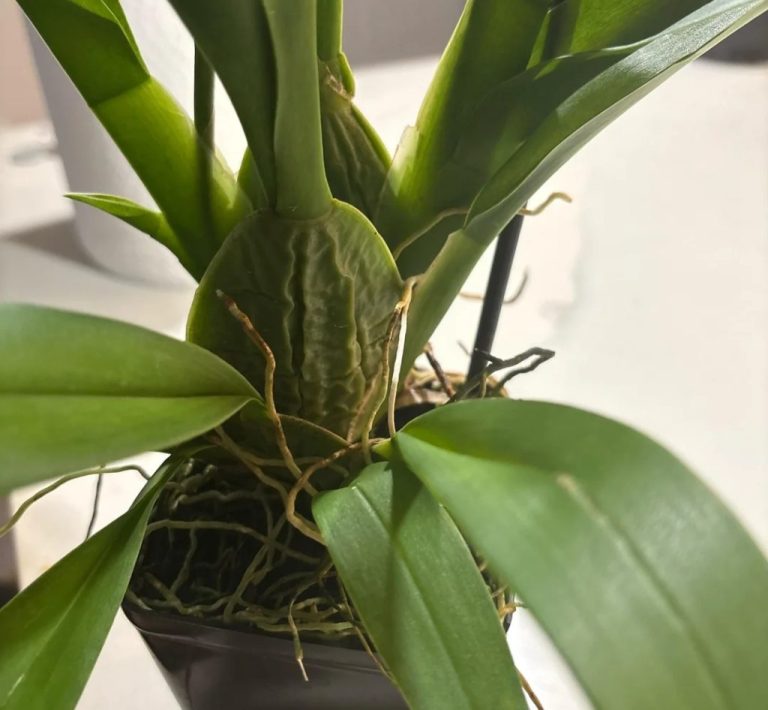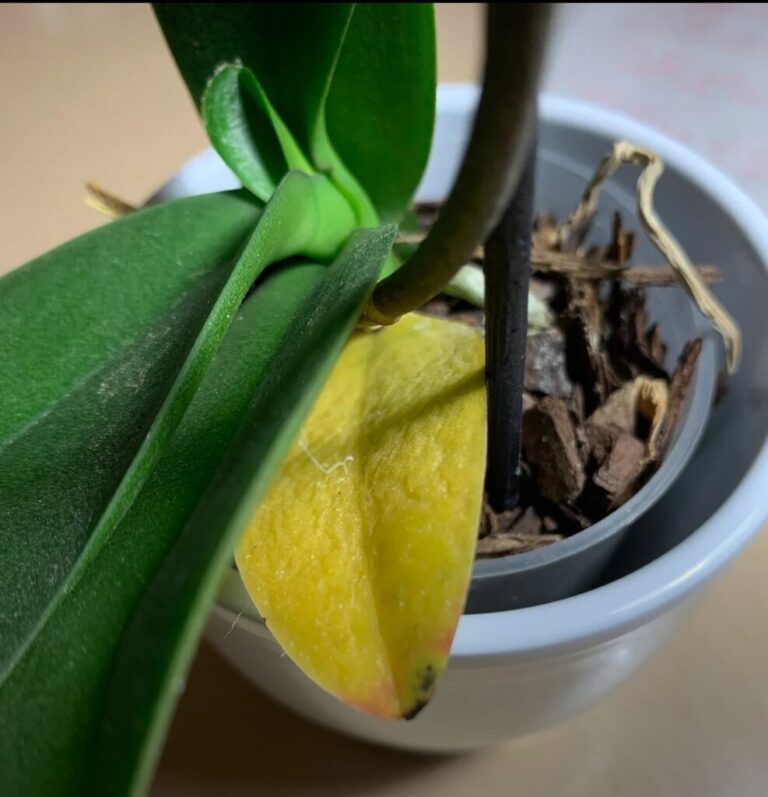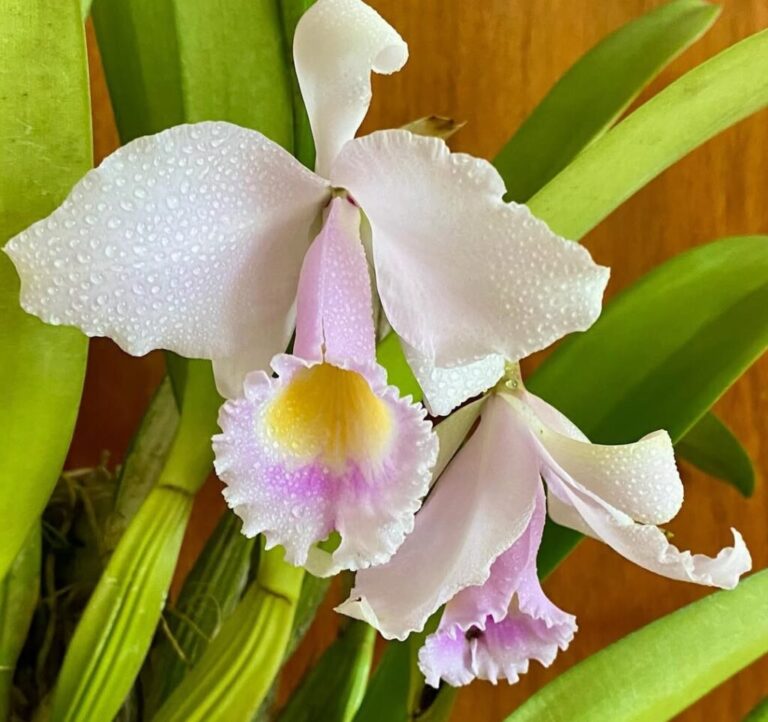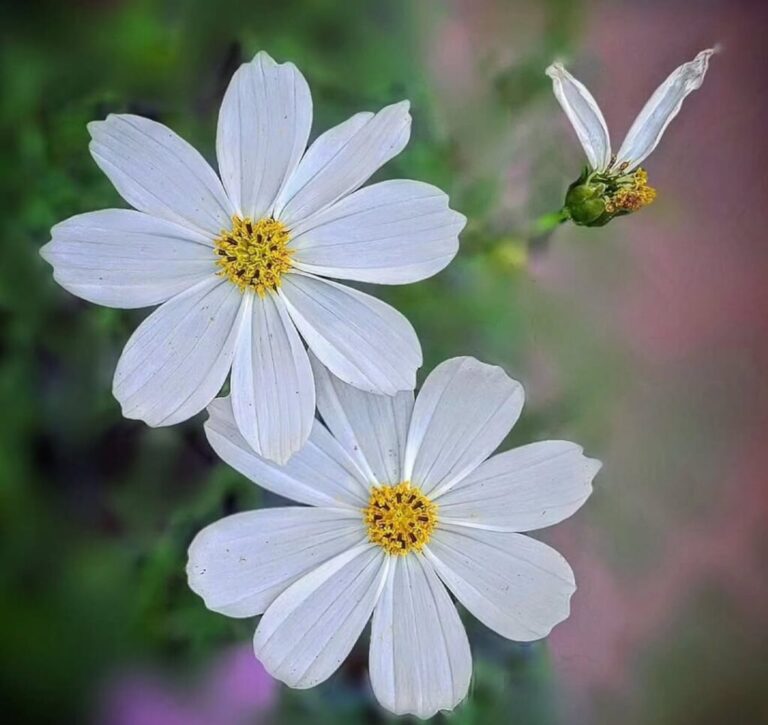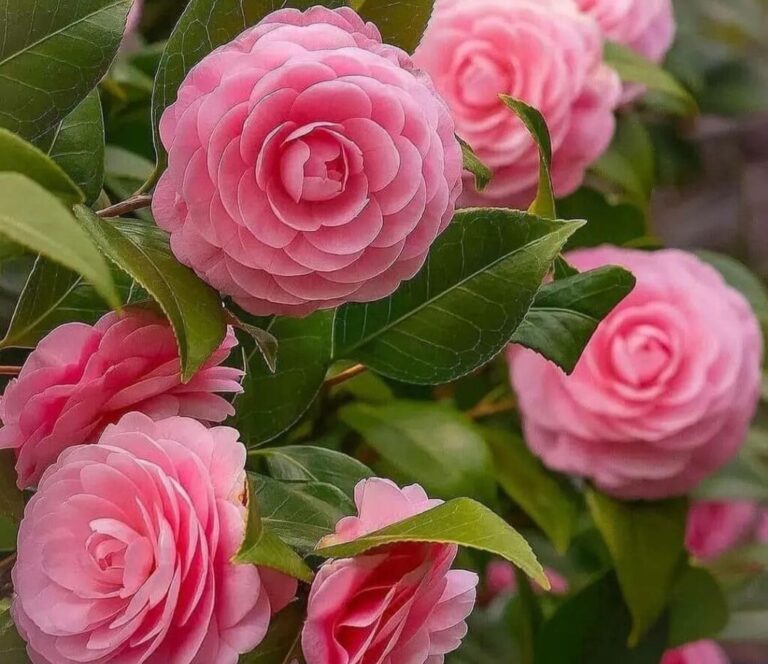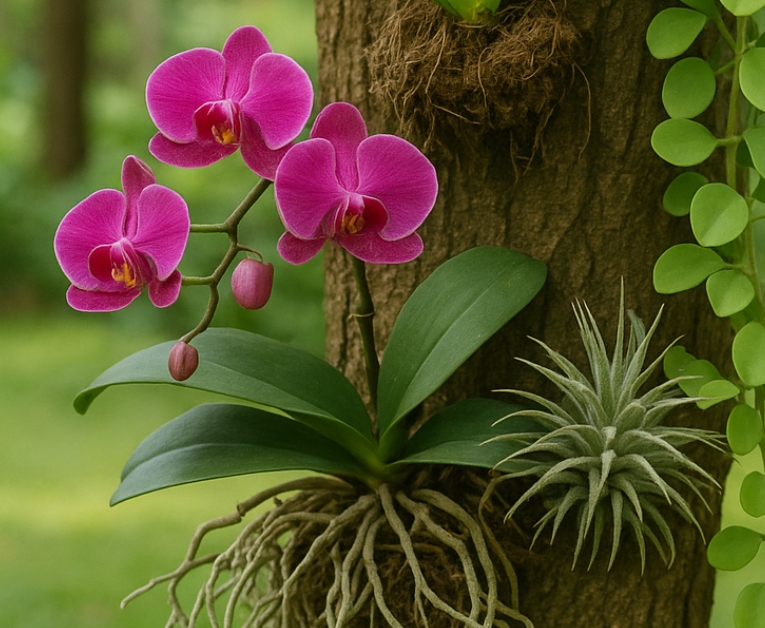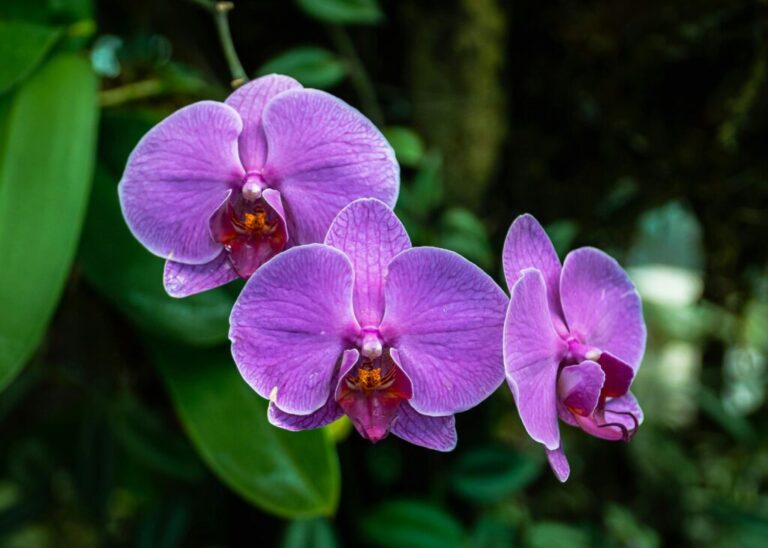Orchid Brown Roots are prized for their breathtaking beauty and the exotic charm they bring to any indoor or outdoor area. Orchids, however, need particular care to survive and thrive, just like any other type of plant. The abrupt browning of the plant’s roots is one of the most frequent concerns orchid owners deal with.
There are a lot of reasons why this can happen, despite the fact that it could seem scary at first. We’ll look at the top 5 causes of browning orchid roots in this article and offer useful advice and treatments for each one. You can maintain your orchids healthy and vibrant for years to come whether you’re an experienced orchid enthusiast or a novice plant parent by being aware of these frequent root issues.
Orchid Brown Roots

see the vase with out holes problem
Drainage is necessary for orchid survival. They normally inhabit a jungle setting with freely flowing water, frequently perched atop trees. Furthermore, orchids are not as tolerant of standing water as other plants are. Because these pots collect water, they suffocate orchid roots; hence, they will die in this environment.
There are some orchids which have brown roots:

Paphiopedilum, commonly known as slipper orchids, is a genus of terrestrial orchids native to Southeast Asia and parts of the Pacific. They are known for their unique slipper-shaped pouch, which serves to trap insects for pollination.this orchid have brown roots naturally.
Paphiopedilum orchids are popular among orchid enthusiasts due to their beautiful flowers and relatively easy care requirements. They prefer a warm and humid environment and should be kept in a well-draining potting mix. They require moderate watering and should be fertilized regularly during the growing season.
There are many different species and cultivars of Paphiopedilum orchids, each with its own unique characteristics and growing requirements. Some popular varieties include Paphiopedilum insigne, Paphiopedilum venustum, and Paphiopedilum hirsutissimum.
Overall, Paphiopedilum orchids are a beautiful and rewarding plant to grow and are a great choice for both beginner and experienced orchid growers alike.
Overwatering is a common cause of brown roots in orchids. When orchids are overwatered, their roots become waterlogged, leading to root rot. As a result, the roots lose their ability to absorb nutrients and oxygen, causing them to turn brown and mushy. Overwatering can be especially problematic for orchids
because they are epiphytes, meaning they typically grow on trees and absorb water and nutrients from the air rather than from the soil. To prevent overwatering, it’s important to allow the orchid’s potting medium to dry out slightly between waterings and to ensure that the pot has good drainage. In some cases, it may be necessary to repot the orchid in fresh potting mix to prevent further damage to the roots.
Fungal or bacterial infections can also cause orchid roots to turn brown. These infections are usually caused by poor growing conditions, such as high humidity, poor ventilation, or using contaminated potting mix. When orchid roots are infected, they may turn brown, become mushy, or even blacken.
If left untreated, the infection can spread to other parts of the plant, causing it to wilt or even die. To prevent fungal or bacterial infections, it’s important to provide good ventilation, avoid
overcrowding, and use a clean potting mix. In addition, it’s important to inspect the plant regularly for signs of infection, such as brown or blackened roots, and to treat any infections promptly using an appropriate fungicide or bactericide. By providing optimal growing conditions and being vigilant about the health of your orchids, you can help prevent brown roots caused by fungal or bacterial infections.
Sunburn:While orchids require bright, indirect sunlight to thrive, direct exposure to the sun can cause their roots to turn brown. This is because direct sunlight can cause the roots to dry out and become damaged, making it difficult for them to absorb nutrients and water. Sunburned roots may appear dry and shriveled, and may eventually turn brown or black
. To prevent sunburned roots, it’s important to place your orchid in a location with bright, filtered sunlight, such as near a window with a sheer curtain. Avoid placing your orchid in a south-facing window, which can receive intense sunlight during the summer months. Additionally, it’s important to ensure that your orchid is not in close proximity to heat sources, such as radiators or air conditioning vents, which can also cause the roots to dry out. By providing your orchid with the right amount of light and ensuring it’s not exposed to direct sunlight, you can help prevent brown roots caused by sunburn.
Chemical burns: can also cause orchid roots to turn brown. This can occur when orchids are exposed to chemicals, such as fertilizers or pesticides, which can be harmful if not used properly. The roots may become discolored and damaged, making it difficult for them to absorb nutrients and water.
To prevent chemical burn, it’s important to follow the manufacturer’s instructions carefully when using any chemicals on your orchids. Avoid getting chemicals on the roots, and make sure to dilute fertilizers to the recommended strength. In addition, it’s important to avoid fertilizing orchids that are in distress or have damaged roots, as this can further harm the plant. If you suspect that your orchid has been affected by chemical burn, it’s important to flush the soil thoroughly with water to remove any residual chemicals. By taking care when using chemicals on your orchids, you can help prevent brown roots caused by chemical burn.
Natural aging : Orchids roots can turn brown due to natural aging. As orchids age, their roots will naturally die off and be replaced by new ones. This is a normal part of their life cycle, and it is not a cause for concern unless the roots are also becoming soft or mushy. However, it’s important to note that not all orchids age at the same rate, and factors such as growing conditions and overall health can impact the rate of root loss.
To promote healthy root growth, it’s important to provide your orchid with the right growing conditions, including the correct level of light, temperature, and humidity, as well as appropriate watering and fertilization. Regularly inspecting your orchid’s roots for signs of damage or decay can also help ensure that any issues are identified and treated promptly. By taking steps to promote healthy root growth, you can help ensure that your orchid remains healthy and vibrant for years to come.
How to repot an orchid with brown roots
To repot an orchid with brown roots, you will need to take a few steps. First, remove the orchid from its current pot and carefully remove any dead or brown roots using sterilized pruning shears. Next, select a new pot that is slightly larger than the old one and fill it with fresh orchid potting mix, which typically consists of bark chips, sphagnum moss, and perlite.
Place the orchid into the new pot and add more potting mix around the roots, gently pressing it down to ensure that the orchid is secure. Water the orchid thoroughly, making sure that the potting mix is evenly moist but not waterlogged. It’s important to keep the orchid out of direct sunlight and to monitor it carefully over the next few weeks, ensuring that the potting mix stays evenly moist and that the orchid is adjusting well to its new pot.
Regarding a prescription, it’s important to note that repotting an orchid with brown roots is a physical process and does not require medication. However, it’s important to maintain good hygiene when handling your orchid, as bacteria or fungi can cause infections that may harm your plant. You may want to use gloves and sterilized pruning shears to prevent the spread of any infections and clean your tools thoroughly between uses.
If you notice any signs of infection or damage to your orchid, such as brown or blackened roots, it’s important to treat the issue promptly to prevent further damage. In some cases, you may need to use a fungicide or bactericide to treat an infection, but it’s important to consult with a gardening expert or plant specialist before using any chemical treatments.
Step-by-step reporting brown roots orchid
The outer layer of the roots (velamen) should not be soft and pull off like that even on orchids. They should be firm and white like the new roots that are coming out
If your using bark in media they can color roots brown, but they should not be soft and the velamen should not pull off like that. Really you need to cut all the dead roots and then repot in a way to provide moisture around the remaining roots to help it recover.
Sure, here are step-by-step instructions for repotting an orchid with brown roots:
Prepare the new pot and potting mix: Select a new pot that is slightly larger than the old one and fill it with fresh orchid potting mix. The mix should typically consist of bark chips, sphagnum moss, and perlite.
Remove the orchid from its old pot. Gently remove the orchid from its old pot, taking care not to damage the roots.
Remove any dead or brown roots: Inspect the roots carefully and remove any dead or brown roots using sterilized pruning shears. Trim back the healthy roots as necessary.
Place the orchid in the new pot: Place the orchid in the new pot and add more potting mix around the roots, gently pressing it down to ensure that the orchid is secure.
Water the orchid: Water the orchid thoroughly, making sure that the potting mix is evenly moist but not waterlogged. Allow any excess water to drain away.
Monitor the orchid: Keep the orchid out of direct sunlight and monitor it carefully over the next few weeks, ensuring that the potting mix stays evenly moist and that the orchid is adjusting well to its new pot.
By following these steps, you can successfully repot an orchid with brown roots and help promote healthy growth and vitality in your plant .
FAQ
Are the roots of my orchid turning brown?
The roots of your orchid may be turning brown due to overwatering, poor drainage, or a fungal or bacterial infection.
How do you save brown orchid roots?
To save brown orchid roots, you should trim away any dead or diseased roots, repot the orchid in fresh potting mix with good drainage, and adjust your watering habits
Should I remove brown orchid roots?
You should remove brown orchid roots if they are dead or diseased, but leave healthy roots in place.
Why do my orchids roots keep dying?
Orchid roots can die from a variety of factors, including overwatering, underwatering, poor drainage, root damage, or fungal or bacterial infections.
Unhealthy orchid roots?
Signs of unhealthy orchid roots may include discoloration, softness, sliminess, and an unpleasant odor.
Treating orchid root rot with hydrogen peroxide ?
Hydrogen peroxide can be used to treat orchid root rot, but it should be diluted and applied carefully to avoid damaging the plant.
How to tell if orchid roots are dead ?
You can tell if orchid roots are dead by gently squeezing them – if they feel mushy or break apart easily, they are likely dead.
Dry orchid roots?
Dry orchid roots can indicate underwatering or low humidity.
What does orchid root rot look like?
Orchid root rot may appear as dark, mushy, or slimy roots, or a foul odor coming from the roots or potting mix.
Orchid root rot symptoms?
Symptoms of orchid root rot include wilting, yellowing or browning leaves, and a general decline in plant health.
Orchid root rot vs healthy roots?
Healthy orchid roots should be firm, white or light green, and have a velvety texture.
White orchid roots?
White orchid roots are healthy and indicate that the plant is actively growing and absorbing nutrients.

